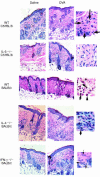Roles of TH1 and TH2 cytokines in a murine model of allergic dermatitis
- PMID: 10207161
- PMCID: PMC408277
- DOI: 10.1172/JCI5669
Roles of TH1 and TH2 cytokines in a murine model of allergic dermatitis
Abstract
Skin lesions in atopic dermatitis (AD) are characterized by hypertrophy of the dermis and epidermis, infiltration by T cells and eosinophils, and expression of the cytokines IL-4, IL-5, and IFN-gamma. The role of these cytokines in the pathogenesis of AD is not known. We took advantage of a recently described murine model of AD elicited by epicutaneous sensitization with ovalbumin (OVA) (1) and of the availability of mice with targeted deletions of the IL-4, IL-5, and IFN-gamma cytokine genes to assess the role of these cytokines in this model.OVA-sensitized skin from IL-5(-/-) mice had no detectable eosinophils and exhibited decreased epidermal and dermal thickening. Sensitized skin from IL-4(-/-) mice displayed normal thickening of the skin layers but had a drastic reduction in eosinophils and a significant increase in infiltrating T cells. These findings were associated with a reduction in eotaxin mRNA and an increase in mRNA for the T-cell chemokines macrophage inflammatory protein-2 (MIP-2), MIP-1beta, and RANTES. Sensitized skin from IFN-gamma-/- mice was characterized by reduced dermal thickening. These results suggest that both the TH2 cytokines IL-4 and IL-5 and the TH1 cytokine IFN-gamma play important roles in the inflammation and hypertrophy of the skin in AD.
Figures






References
-
- Herz U, Bunikowski R, Renz H. Role of T cells in atopic dermatitis. Int Arch Allergy Immunol. 1998;115:179–190. - PubMed
-
- Leung DYM. Immunopathology of atopic dermatitis. Springer Semin Immunopathol. 1992;13:427–440. - PubMed
-
- Leiferman KM, et al. Dermal deposition of eosinophil-granule major basic protein in atopic dermatitis: comparison with onchocerciasis. N Engl J Med. 1985;313:282–285. - PubMed
-
- Cheng J, et al. Dermal eosinophils in atopic dermatitis undergo cytolytic degeneration. J Allergy Clin Immunol. 1997;99:683–692. - PubMed
-
- Yamamoto S, Hamasaki Y, Ishii E, Ichimaru T, Miyazaki S. Unbalanced production of interleukin-5 and interleukin-2 in children with atopic dermatitis. Ann Allergy Asthma Immunol. 1997;78:517–523. - PubMed
Publication types
MeSH terms
Substances
Grants and funding
LinkOut - more resources
Full Text Sources
Other Literature Sources
Molecular Biology Databases

